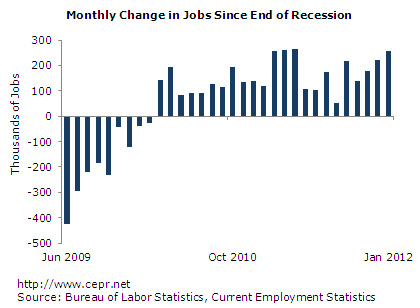February 03, 2012
February 3, 2012 (Jobs Byte)
By Dean Baker
Unemployment for African American men fell by 3.0 percentage points in January.
The Labor Department reported that the unemployment rate fell to 8.3 percent in January, bringing its drop over the last year to 0.8 percentage points. African Americans in particular saw an especially sharp decline in unemployment, with their overall rate falling by 2.2 percentage points to 13.6 percent, the lowest level since March of 2009. The unemployment rate for African American men over age 20 fell by 3.0 percentage points to 12.7 percent, the lowest level since November of 2008. The drop for women over age 20 was 1.3 percentage points to 12.6 percent. The unemployment rate for Hispanics dropped by 0.5 percentage points to 10.5 percent, the lowest since January of 2009. These numbers are erratic and may be partially reversed in future months.
The gains for whites were more modest, with the overall unemployment rate edging down by 0.1 percentage points to 7.4 percent. The unemployment rate for white men over age 20 fell by 0.2 percentage points to 6.9 percent, while it was unchanged for women over age 20 at 6.8 percent. The unemployment rate for all men and women over age 20 is now the same at 7.7 percent, the first time they have been equal since the recession began in December, 2007.
Other data in the household survey were more mixed. There was a small rise in the number of workers unemployed involuntarily; although, this followed sharp declines the prior two months. The percentage of unemployment due to quits edged up slightly, but remains very low and even below the levels of October and November.
The establishment survey showed a gain of 243,000 jobs with the private sector adding 257,000. With upward revisions to job growth for the prior two months, job growth has now averaged 201,000 over the last three months. Ignoring Census hiring, this is the strongest three-month stretch since February to April of last year when job growth averaged 239,000 a month.

The revisions actually improved the picture more than may be apparent, since a quirky 42,200 rise in courier jobs for December was completely eliminated in the revision. Instead, the revised data show a 63,000 increase in jobs in professional and technical services for December, instead of the 12,000 previously reported. This was largely due to more jobs in employment services, which reportedly rose by 21,800 in December and by 33,200 last month. This is the sort of healthy job growth in this sector that often precedes more permanent hires.
Manufacturing employed increased by 50,000 in January after rising by 32,000 in December. Most of the jobs came in the fabricated metal, machinery and transportation sector. Construction also had strong growth for the second-consecutive month, adding 21,000 jobs in January after an increase of 31,000 in December. Undoubtedly this rise was partly a result of unusually good weather in the Northeast and Midwest.
Health care employment rose by 30,900 in January after three months in which employment growth averaged just 15,000. Restaurants added 30,000 in January, somewhat above the 25,000 average over the last year. State and local employment fell by just 8,000, the smallest drop since June. The impact of cutbacks at this level may be diminishing in the months ahead. Federal government employment fell by 6,000 in January. This is likely to continue, but because there are many fewer federal employees, the rate of job loss has less impact than the state and local job cuts.
Wage growth has averaged 1.6 percent over the last quarter, roughly the same rate as over the last year. Average weekly hours were unchanged overall, but rose by 0.3 hours in manufacturing. This could indicate more hiring in future months.
The January report is undoubtedly one of the best reports that we have seen since the recession began. Clearly weather played some role in making the report better than otherwise would be the case, most obviously in the construction data, but good weather probably led to somewhat better numbers for manufacturing and restaurants as well. However, even with some reversal of this effect in future months, it is likely that we are on a somewhat stronger job growth path, perhaps as high as 200,000 a month. While this is markedly better than what we had been seeing, at this rate we would not get back to full employment until 2020.






